Effects of Polypropylene Fibre and Strain Rate on Dynamic Compressive Behaviour of Concrete
Abstract
1. Introduction
2. Experimental Program
2.1. Raw Materials
2.2. Mixture Proportions
2.3. Specimen Preparation
2.4. Test Methods
2.4.1. Workability and Static Compressive Test
2.4.2. Dynamic Compressive Test
2.4.3. SEM Test
3. Results and Discussion
3.1. Workability
3.2. Static Compressive Strength
3.3. Dynamic Compressive Stress-Strain Relationship
3.3.1. Effect of Strain Rate
3.3.2. Effect of Polypropylene Fibre Content
3.4. Dynamic Failure Mode
4. Conclusions
- The incorporation of PP fibres enhanced the dynamic compressive behaviour but reduced the workability and static compressive strength of concrete mixtures. PP36 exhibited the lowest workability among all mixtures, where its workability reduced 14.6% as compared to PP00. The optimal PP fibre content was found 0.9 kg/m3 (i.e., PP09) in terms of workability, and static and dynamic compressive properties as PP09 exhibited the best workability among all PP fibre reinforced concrete mixtures and showed the least reduction (5.8%) in static compressive strength and an increase of 7.7% in DIF when the strain rate was120 s−1 compared to PP00.
- The ‘strain rate effect’ can be observed for all mixtures regarding the dynamic compressive properties. As strain rate increased, dynamic compressive strength of all mixtures increased and the DIF of all mixtures was enhanced gradually.
- High correlation coefficients of the fitted DIF curves can be found for all mixtures, which indicates that the proposed equations can be used to describe well the relationship between the DIF and strain rate of PP fibre reinforced concrete under impact loading.
- When the strain rate is relatively low, PP fibres were efficient in controlling the growth of micro-cracks under impact loading. However, the effectiveness of PP fibres was reduced when the strain rate was increased, which can be mainly attributed to the extremely short impact loading time.
Author Contributions
Funding
Acknowledgments
Conflicts of Interest
References
- Parande, A.K.; Babu, B.R.; Karthik, M.A.; Deepak, K.-K.; Palaniswamy, N. Study on strength and corrosion performance for steel embedded in metakaolin blended concrete/mortar. Constr. Build. Mater. 2008, 22, 127–134. [Google Scholar] [CrossRef]
- Fu, Q.; Niu, D.; Zhang, J.; Huang, D.; Wang, Y.; Hong, M.; Zhang, L. Dynamic compressive mechanical behaviour and modelling of basalt-polypropylene fibre-reinforced concrete. Arch. Civ. Mech. Eng. 2018, 18, 914–927. [Google Scholar] [CrossRef]
- Song, P.S.; Hwang, S.; Sheu, B.C. Strength properties of nylon- and polypropylene-fiber-reinforced concretes. Cem. Concr. Res. 2005, 35, 1546–1550. [Google Scholar] [CrossRef]
- Zhang, W.; Zhang, Y. Research on the static and dynamic compressive properties of high performance cementitious composite (HPCC) containing coarse aggregate. Arch. Civ. Mech. Eng. 2015, 15, 711–720. [Google Scholar] [CrossRef]
- Fang, G.; Liu, Y.; Qin, S.; Ding, W.; Zhang, J.; Hong, S.; Xing, F.; Dong, B. Visualized tracing of crack self-healing features in cement/microcapsule system with X-ray microcomputed tomography. Constr. Build. Mater. 2018, 179, 336–347. [Google Scholar] [CrossRef]
- Luccioni, B.; Isla, F.; Codina, R.; Ambrosini, D.; Zerbino, R.; Giaccio, G.; Torrijos, M.C. Effect of steel fibers on static and blast response of high strength concrete. Int. J. Impact. Eng. 2017, 107, 23–37. [Google Scholar] [CrossRef]
- Li, W.; Xu, J. Mechanical properties of basalt fiber reinforced geopolymeric concrete under impact loading. Mater. Sci. Eng. A 2009, 505, 178–186. [Google Scholar] [CrossRef]
- Nedeljkovic, M.; Lukovic, M.; van Breugel, K.; Hordijk, D.; Ey, G. Development and application of an environmentally friendly ductile alkali-activated composite. J. Cleaner. Prod. 2018, 180, 524–538. [Google Scholar] [CrossRef]
- Wu, Z.; Shi, C.; He, W.; Wang, D. Static and dynamic compressive properties of ultra-high performance concrete (UHPC) with hybrid steel fiber reinforcements. Cem. Concr. Compos. 2017, 79, 148–157. [Google Scholar] [CrossRef]
- Ali, M.A.E.M.; Nehdi, M.L. Innovative crack-healing hybrid fiber reinforced engineered cementitious composite. Constr. Build. Mater. 2017, 150, 689–702. [Google Scholar] [CrossRef]
- Ali, M.A.E.M.; Soliman, A.M.; Nehdi, M.L. Hybrid-fiber reinforced engineered cementitious composite under tensile and impact loading. Mater. Des. 2017, 117, 139–149. [Google Scholar] [CrossRef]
- Hao, Y.; Hao, H. Dynamic compressive behaviour of spiral steel fibre reinforced concrete in split Hopkinson pressure bar tests. Constr. Build. Mater. 2013, 48, 521–532. [Google Scholar] [CrossRef]
- Romualdi, J.P.; Batson, G.B. Mechanics of crack arrest in concrete. J. Eng. Mech. Div. 1963, 89, 147–168. [Google Scholar]
- Su, Y.; Li, J.; Wu, C.; Wu, P.; Li, Z. Effects of steel fibres on dynamic strength of UHPC. Constr. Build. Mater. 2016, 114, 708–718. [Google Scholar] [CrossRef]
- Mao, L.; Barnett, S.J. Investigation of toughness of ultra high performance fibre reinforced concrete (UHPFRC) beam under impact loading. Int. J. Impact. Eng. 2017, 99, 26–38. [Google Scholar] [CrossRef]
- Karimi, M.M.; Darabi, M.K.; Jahanbakhsh, H.; Jahangiri, B.; Rushing, J.F. Effect of steel wool fibers on mechanical and induction heating response of conductive asphalt concrete. Int. J. Pav. Eng. 2019, 1–14. [Google Scholar] [CrossRef]
- Fu, Q.; Niu, D.; Zhang, J.; Huang, D.; Hong, M. Impact response of concrete reinforced with hybrid basalt-polypropylene fibers. Powder. Technol. 2018, 326, 411–424. [Google Scholar] [CrossRef]
- Mo, K.H.; Yap, S.P.; Alengaram, U.J.; Jumaat, M.Z.; Bu, C.H. Impact resistance of hybrid fibre-reinforced oil palm shell concrete. Constr. Build. Mater. 2014, 50, 499–507. [Google Scholar] [CrossRef]
- Toutanji, H.; McNeil, S.; Bayasi, Z. Chloride permeability and impact resistance of polypropylene-fiber-reinforced silica fume concrete. Cem. Concr. Res. 1998, 28, 961–968. [Google Scholar] [CrossRef]
- Zhang, H.; Liu, Y.; Sun, H.; Wu, S. Transient dynamic behavior of polypropylene fiber reinforced mortar under compressive impact loading. Constr. Build. Mater. 2016, 111, 30–42. [Google Scholar] [CrossRef]
- Jahanbakhsh, H.; Karimi, M.M.; Tabatabaee, N. Experimental and numerical investigation of low-temperature performance of modified asphalt binders and mixtures. Road. Mater. Pavement. Des. 2016, 1–22. [Google Scholar] [CrossRef]
- Karimi, M.M.; Jahanbakhsh, H.; Jahangiri, B.; Nejad, F.M. Induced heating-healing characterization of activated carbon modified asphalt concrete under microwave radiation. Constr. Build. Mater. 2018, 178, 254–271. [Google Scholar] [CrossRef]
- Jahanbakhsh, H.; Karimi, M.M.; Jahangiri, B.; Nejad, F.M. Induction heating and healing of carbon black modified asphalt concrete under microwave radiation. Constr. Build. Mater. 2018, 174, 656–666. [Google Scholar] [CrossRef]
- Zhang, W.; Chen, S.; Liu, Y. Effect of weight and drop height of hammer on the flexural impact performance of fiber-reinforced concrete. Constr. Build. Mater. 2017, 140, 31–35. [Google Scholar] [CrossRef]
- Bhutta, A.; Borges, P.H.R.; Zanotti, C.; Farooq, M.; Banthia, N. Flexural behavior of geopolymer composites reinforced with steel and polypropylene macro fibers. Cem. Concr. Compos. 2017, 80, 31–40. [Google Scholar] [CrossRef]
- Wu, Y.; Song, W.; Zhao, W.; Tan, X. An Experimental Study on Dynamic Mechanical Properties of Fiber-Reinforced Concrete under Different Strain Rates. Appl. Sci. 2018, 8, 1904. [Google Scholar]
- Wang, S.; Zhang, M.H.; Quek, S.T. Effect of high strain rate loading on compressive behaviour of fibre-reinforced high-strength concrete. Mag. Concr. Res. 2011, 63, 813–827. [Google Scholar] [CrossRef]
- Ibrahim, S.M.; Almusallam, T.H.; Al-Salloum, Y.A.; Abadel, A.A.; Abbas, H. Strain rate dependent behavior and modeling for compression response of hybrid fiber reinforced concrete. Lat. Am. J. Solids. Struct. 2016, 13, 1695–1715. [Google Scholar] [CrossRef]
- ASTM C128-15. Standard Test Method for Relative Density (Specific Gravity) and Absorption of Fine Aggregate; ASTM International: West Conshohocken, PA, USA, 2015. [Google Scholar]
- ASTM C127-15. Standard Test Method for Relative Density (Specific Gravity) and Absorption of Coarse Aggregate; ASTM International: West Conshohocken, PA, USA, 2015. [Google Scholar]
- Ranjbar, N.; Talebian, S.; Mehrali, M.; Kuenzel, C.; Cornelis Metselaar, H.-S.; Jumaat, M.-Z. Mechanisms of interfacial bond in steel and polypropylene fiber reinforced geopolymer composites. Compos. Sci. Technol. 2016, 122, 73–81. [Google Scholar] [CrossRef]
- ASTM C143-15a. Standard Test Method for Slump of Hydraulic-Cement Concrete; ASTM International: West Conshohocken, PA, USA, 2015. [Google Scholar]
- Ministry of Construction of the People’s Republic of China. Standard for Test MEthod of Mechanical Properties on Ordinary Concrete; GB/T50081-2002; China Architecture & Building Press: Beijing, China, 2003.
- Chen, M.; Chen, W.; Zhong, H.; Chi, D.; Wang, Y.; Zhang, M. Experimental study on dynamic compressive behaviour of recycled tyre polymer fibre reinforced concrete. Cem. Concr. Compos. 2019, 98, 95–112. [Google Scholar] [CrossRef]
- Li, W.; Xu, J.; Zhai, Y.; Li, Q. Mechanical properties of carbon fiber reinforced concrete under impact loading. China. Civ. Eng. J. 2009, 42, 24–30. (In Chinese) [Google Scholar]
- Kim, D.-J.; Sirijaroonchai, K.; El-Tawil, S.; Naaman, A.-E. Numerical simulation of the Split Hopkinson Pressure Bar test technique for concrete under compression. Int. J. Impact. Eng. 2010, 37, 141–149. [Google Scholar] [CrossRef]
- Akca, K.-R.; Çakir, O.; Ipek, M. Properties of polypropylene fiber reinforced concrete using recycled aggregates. Constr. Build. Mater. 2015, 98, 620–630. [Google Scholar] [CrossRef]
- Qian, C.; Stroeven, P. Development of hybrid polypropylene-steel fibre-reinforced concrete. Cem. Concr. Res. 2000, 30, 63–69. [Google Scholar] [CrossRef]
- Jameran, A.; Ibrahim, I.-S.; Yazan, S.-H.; Rahim, S.-N. Mechanical Properties of Steel-polypropylene Fibre Reinforced Concrete Under Elevated Temperature. Procedia Eng. 2015, 125, 818–824. [Google Scholar] [CrossRef]
- Zhang, H.; Wang, B.; Xie, A.; Qi, Y. Experimental study on dynamic mechanical properties and constitutive model of basalt fiber reinforced concrete. Constr. Build. Mater. 2017, 152, 154–167. [Google Scholar] [CrossRef]
- Cotsovos, D.M.; Pavlovic, M.N. Numerical investigation of concrete subjected to compressive impact loading. Part 1: A fundamental explanation for the apparent strength gain at high loading rates. Comput. Struct. 2008, 86, 145–163. [Google Scholar] [CrossRef]
- Cotsovos, D.M.; Pavlovic, M.N. Numerical investigation of concrete subjected to compressive impact loading. Part 2: Parametric investigation of factors affecting behaviour at high loading rates. Comput. Struct. 2008, 86, 164–180. [Google Scholar] [CrossRef]
- Ross, C.-A.; Jerome, D.-M.; Tedesco, J.-W.; Hughes, M.-L. Moisture and strain rate effects on concrete strength. ACI. Mater. J. 1996, 93, 293–300. [Google Scholar]
- Tedesco, J.-W.; Ross, C.-A. Strain-Rate-Dependent Constitutive Equations for Concrete. J. Press. Vess-T. 1998, 120, 398–405. [Google Scholar] [CrossRef]
- Mangat, P.-S. Tensile strength of steel fiber reinforced concrete. Cem. Concr. Res. 1976, 428, 245–252. [Google Scholar] [CrossRef]
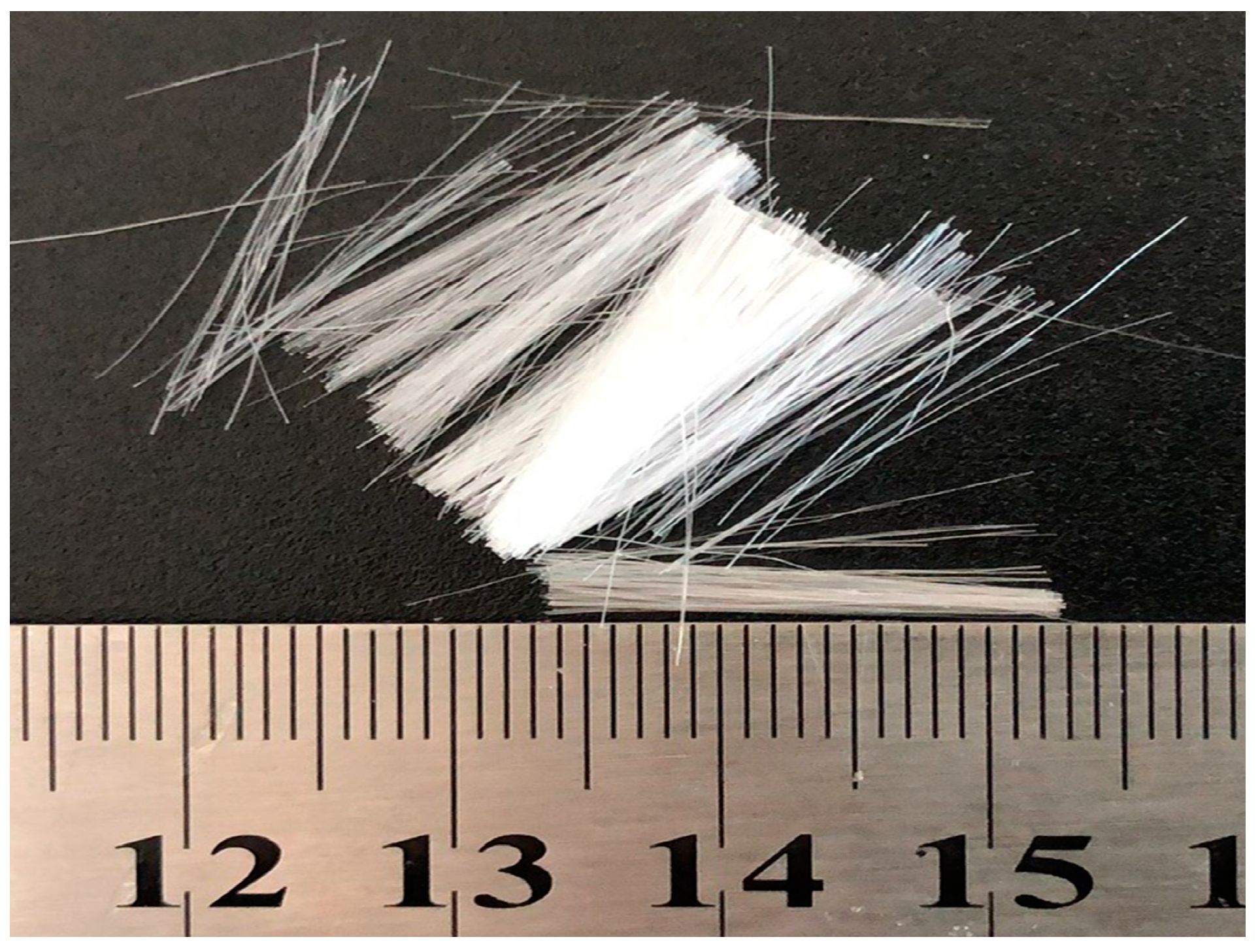

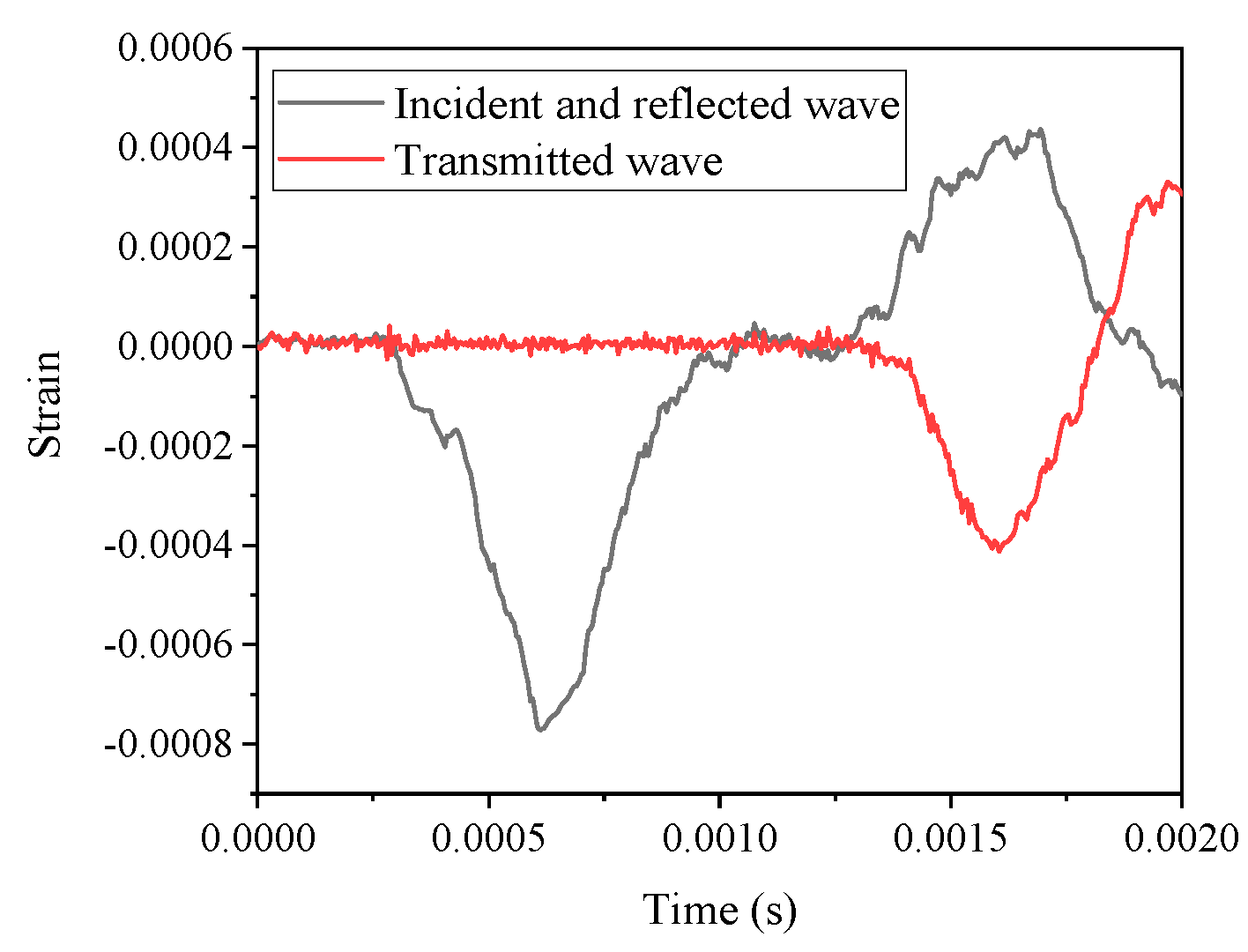
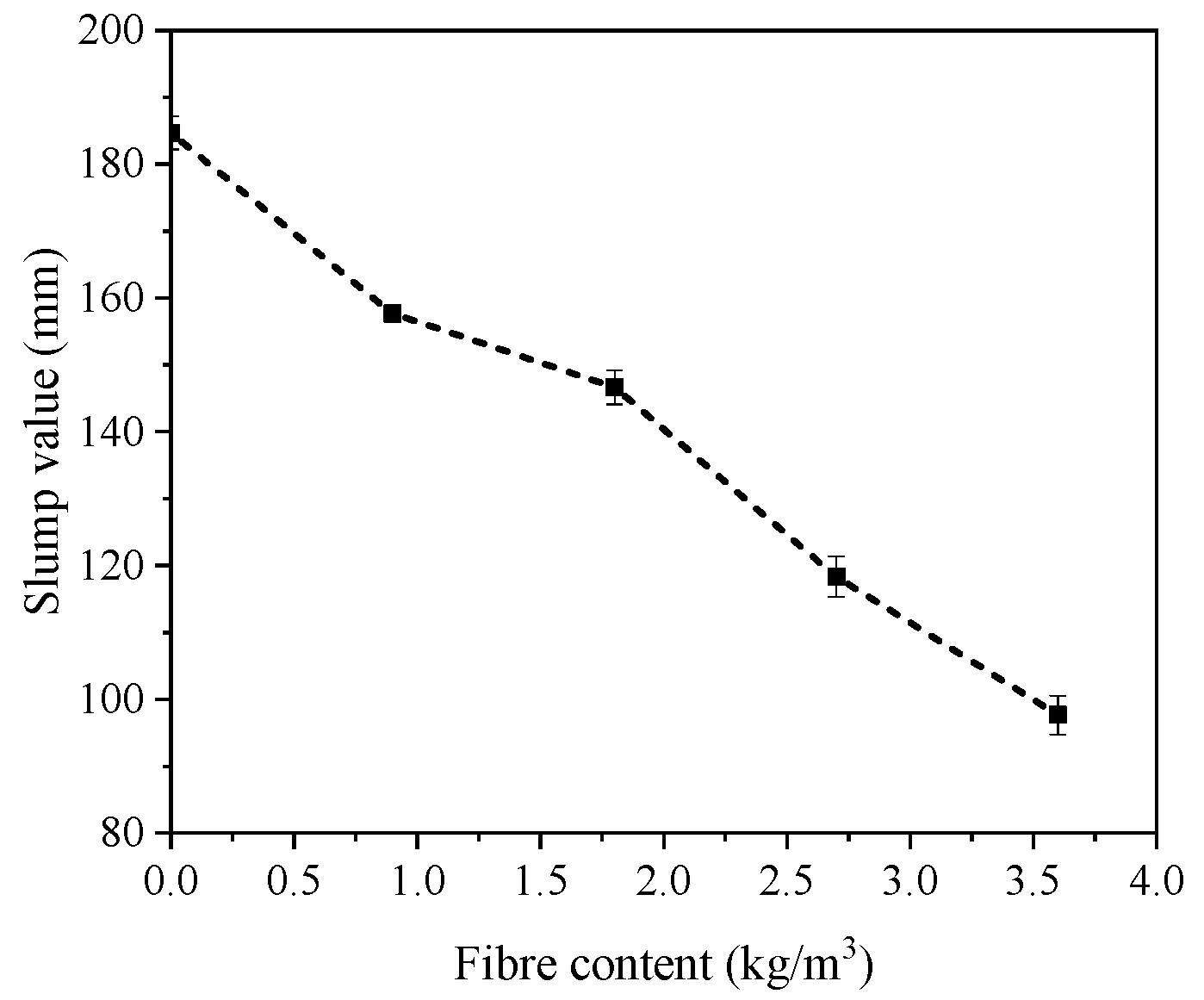
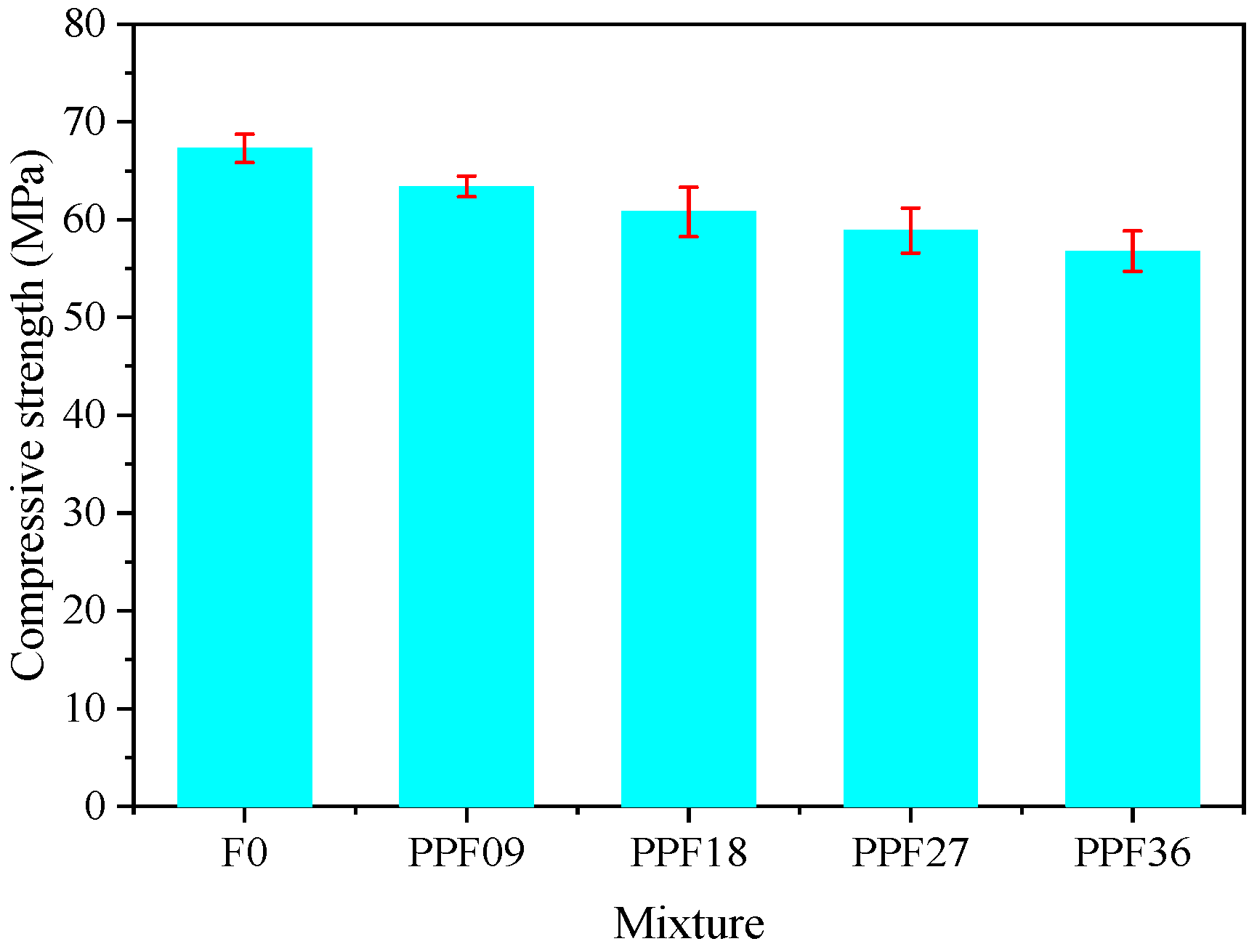
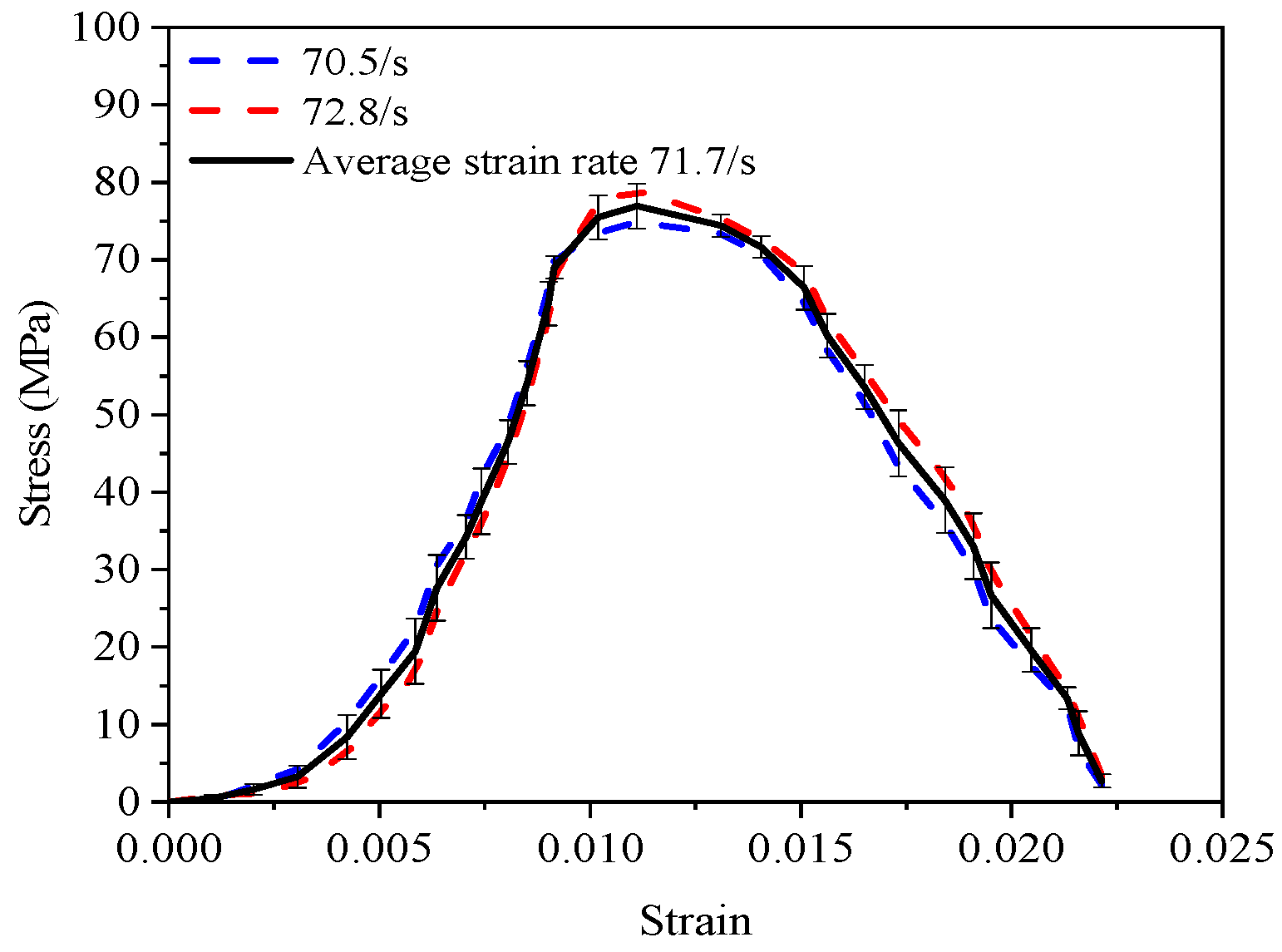
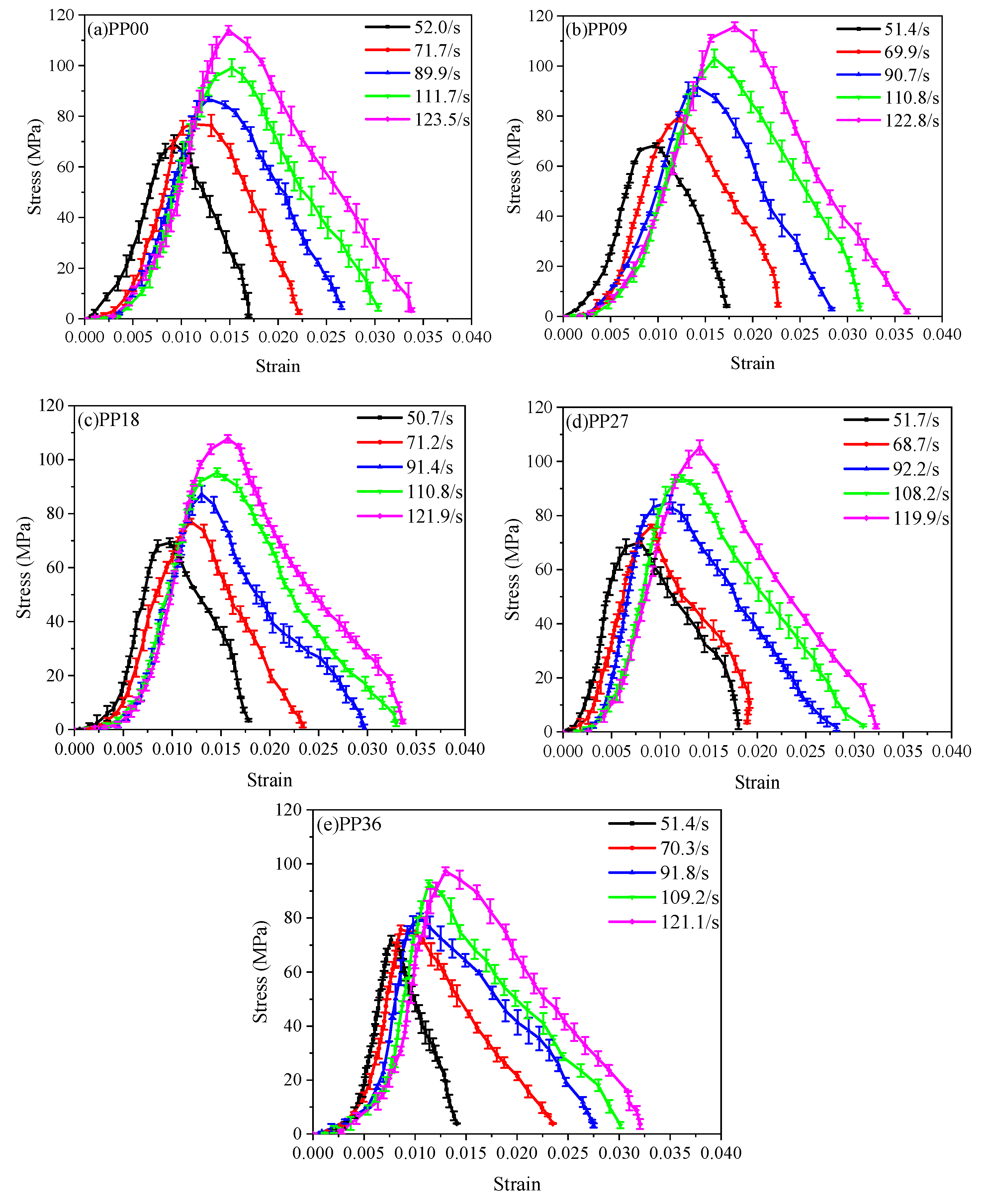
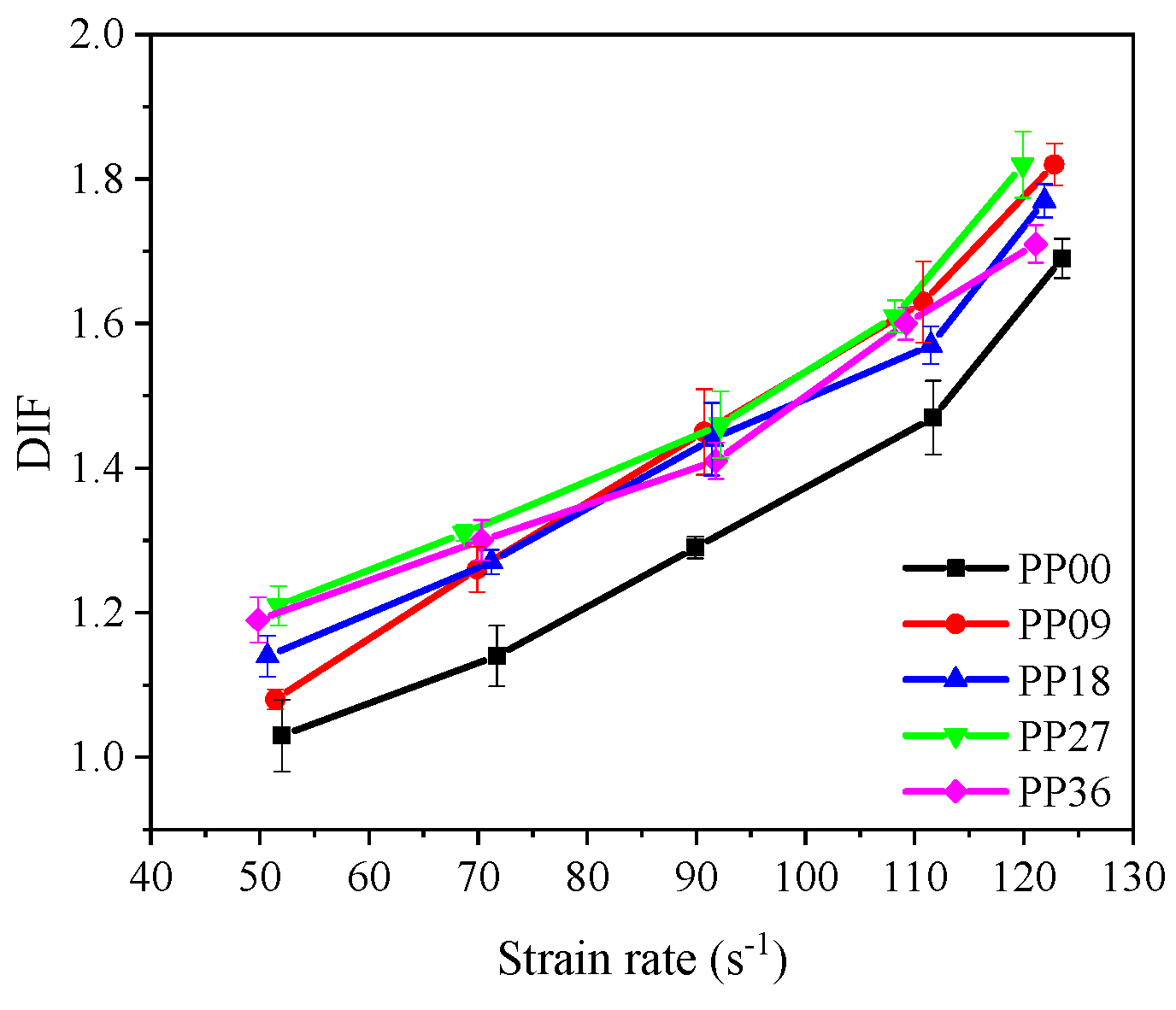
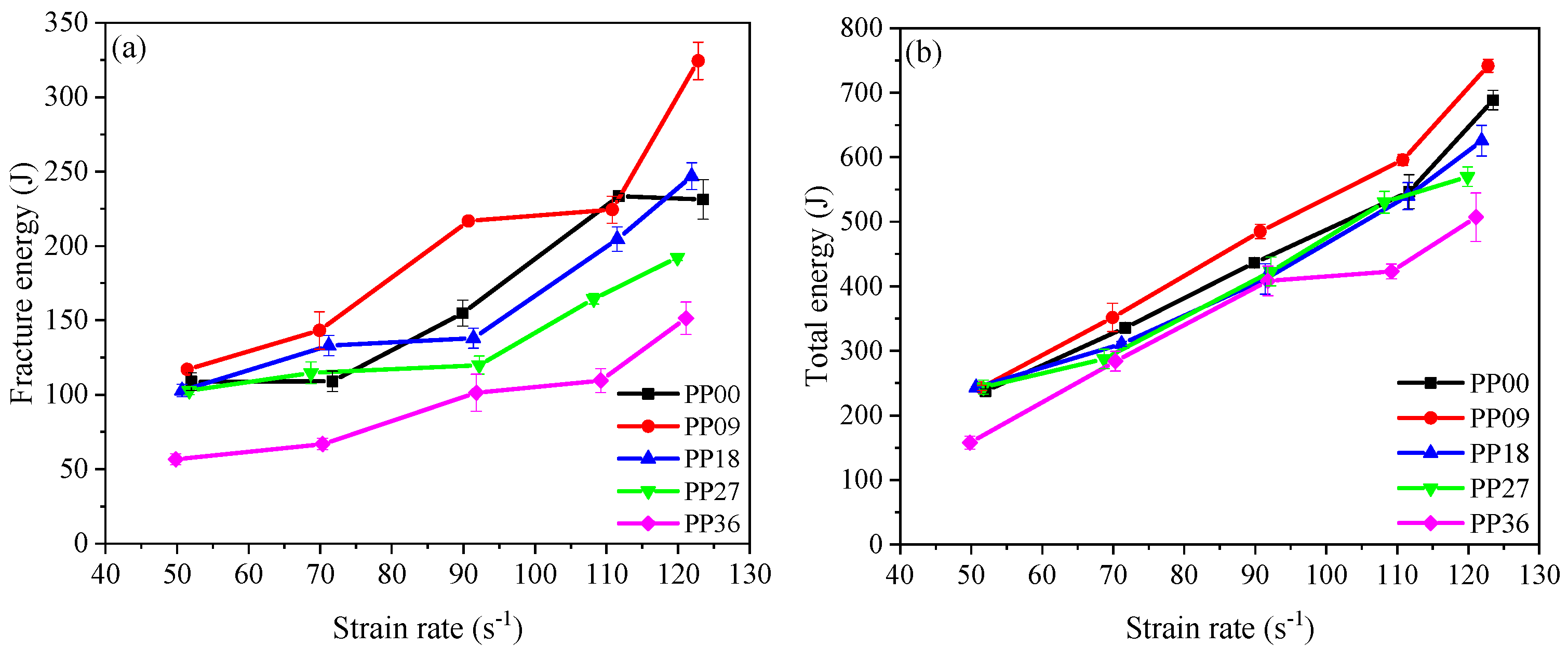
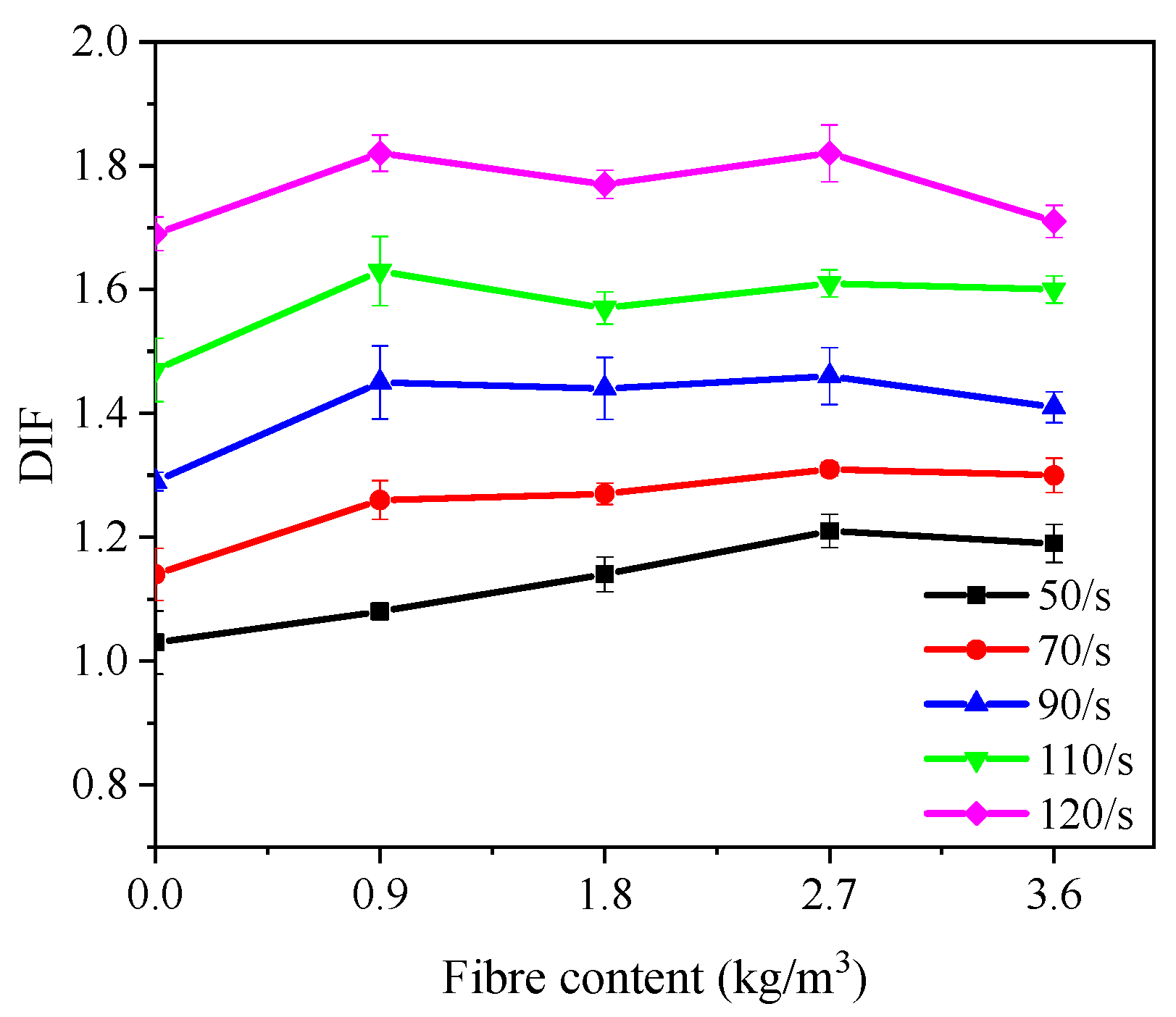
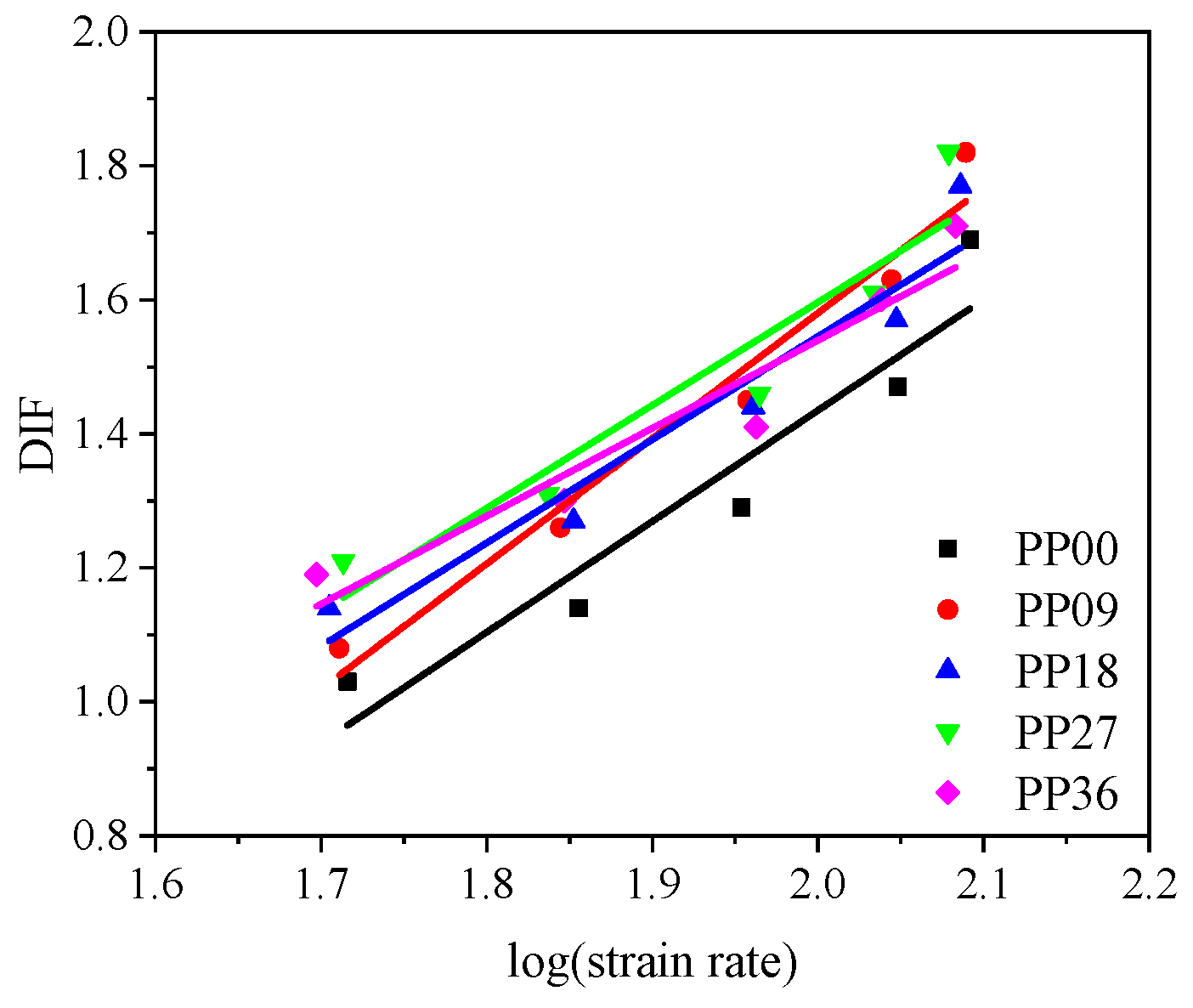


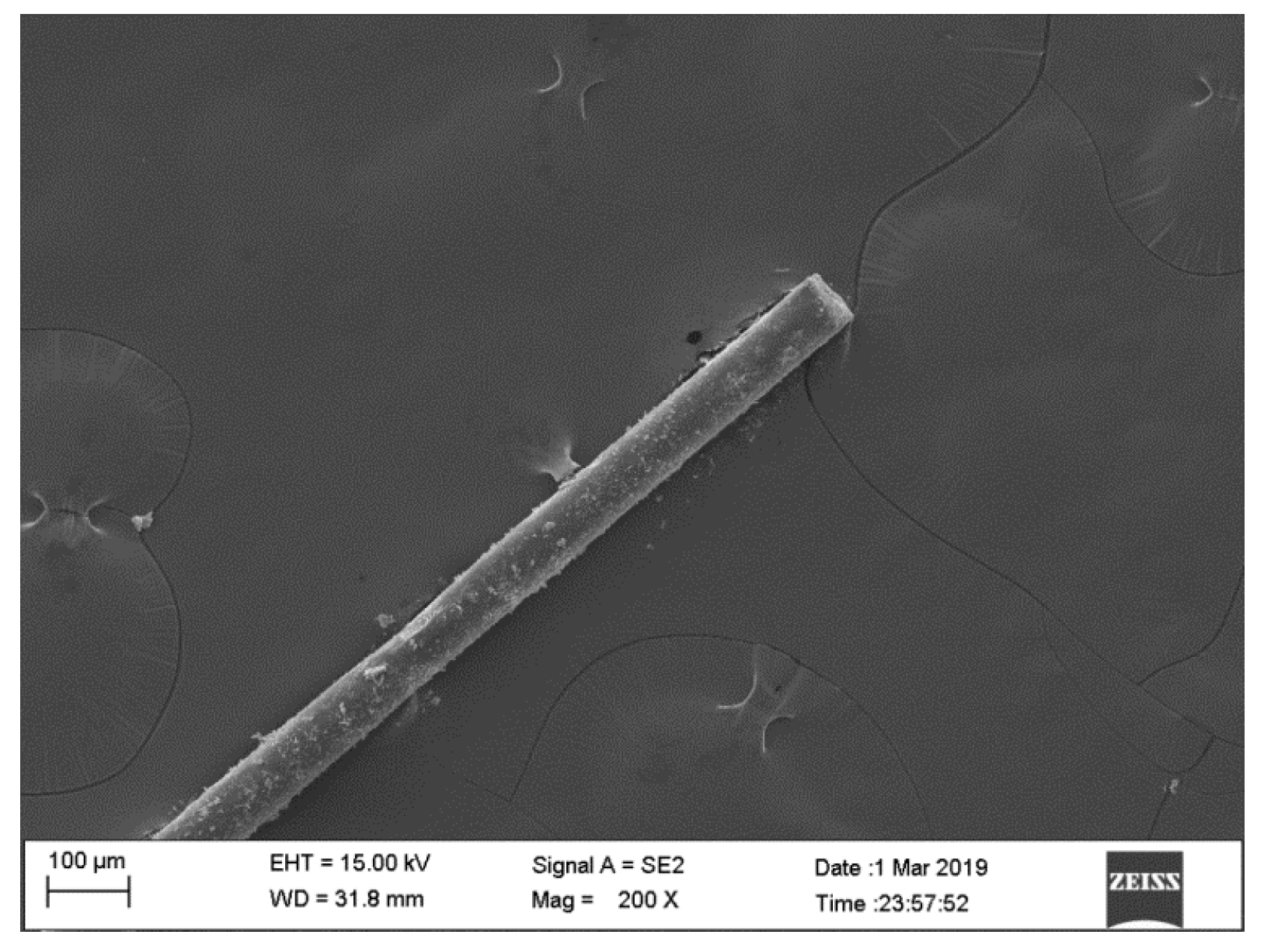
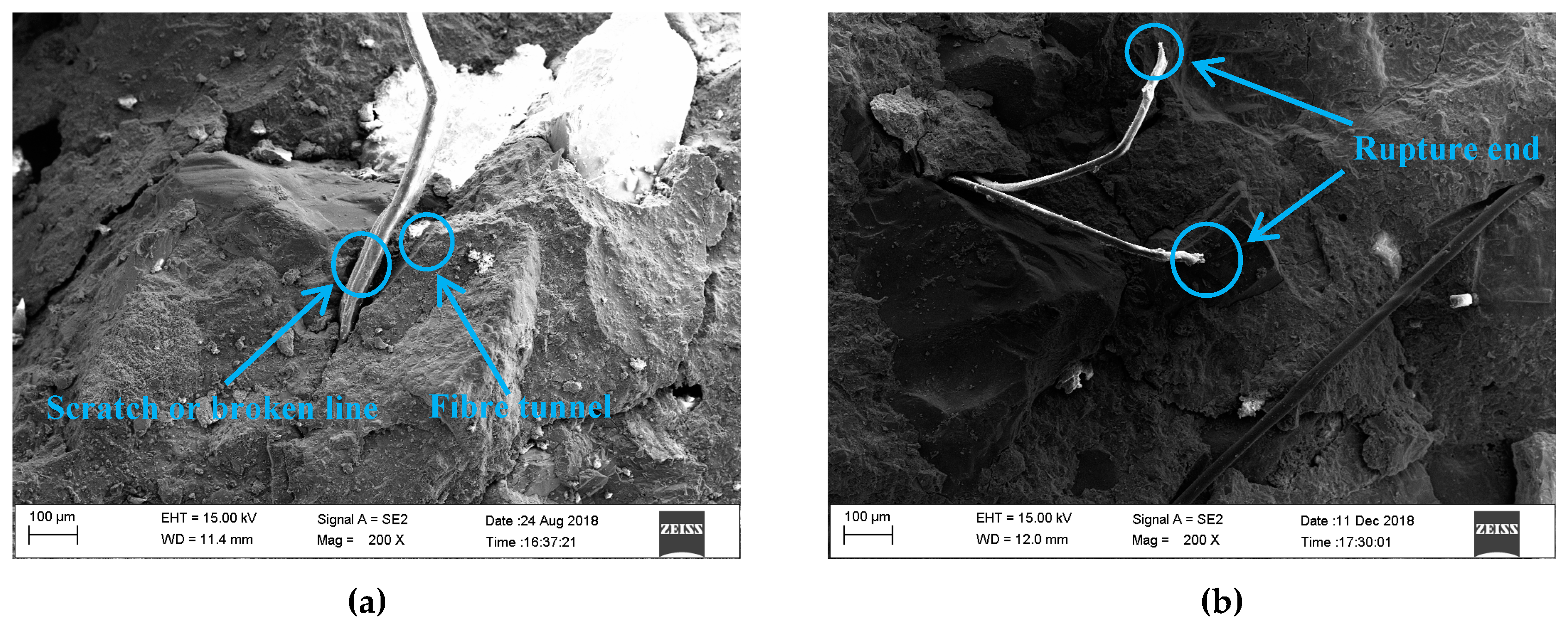
| Oxide | SiO2 | Al2O3 | CaO | Fe2O3 | SO3 | MgO | Na2O | K2O | LOI |
|---|---|---|---|---|---|---|---|---|---|
| Cement | 21.35 | 5.98 | 60.56 | 2.91 | 2.05 | 2.22 | 0.21 | 0.75 | 3.97 |
| Sieve Size (mm) | 4.75 | 2.36 | 1.18 | 0.60 | 0.30 | 0.15 | 0.075 |
| Total Percentage Retained (%) | 0 | 10.5 | 27.8 | 51.5 | 76.2 | 90.8 | 98.6 |
| Sieve Size (mm) | 20.0 | 19.0 | 16.0 | 13.2 | 9.5 | 4.75 |
| Total Percentage Retained (%) | 0 | 2.6 | 18.3 | 55.3 | 85.4 | 98.1 |
| Fibre Type | Length (mm) | Diameter (μm) | Fibre Strength (MPa) | Density (kg/m3) | Modulus of Elasticity (GPa) |
|---|---|---|---|---|---|
| PP | 19 | 26 | 376 | 910 | 3.79 |
| No. | Symbol | Cement (kg/m3) | Water (kg/m3) | FA (kg/m3) | CA (kg/m3) | SPs (kg/m3) | PP Fibre (kg/m3) | Vf (%) |
|---|---|---|---|---|---|---|---|---|
| 1 | PP00 | 569 | 136 | 645 | 1100 | 5.69 | 0.0 | / |
| 2 | PP09 | 569 | 136 | 645 | 1100 | 5.69 | 0.9 | 0.1 |
| 3 | PP18 | 569 | 136 | 645 | 1100 | 5.69 | 1.8 | 0.2 |
| 4 | PP27 | 569 | 136 | 645 | 1100 | 5.69 | 2.7 | 0.3 |
| 5 | PP36 | 569 | 136 | 645 | 1100 | 5.69 | 3.6 | 0.4 |
| Symbol | Number of Specimens | Strain Rate Rype (s−1) | |||||
|---|---|---|---|---|---|---|---|
| Static Specimens | Dynamic Specimens | 50 | 70 | 90 | 110 | 120 | |
| PP00 | 3 | 15 | 3 | 3 | 3 | 3 | 3 |
| PP09 | 3 | 15 | 3 | 3 | 3 | 3 | 3 |
| PP18 | 3 | 15 | 3 | 3 | 3 | 3 | 3 |
| PP27 | 3 | 15 | 3 | 3 | 3 | 3 | 3 |
| PP36 | 3 | 15 | 3 | 3 | 3 | 3 | 3 |
| Symbol | Average Strain Rate (s−1) | Maximum Dynamic Stress (MPa) | Strain at Peak Stress (×10−3) | Ultimate Strain (×10−3) | Static Compressive Strength (MPa) | DIF | Fracture Energy (J) | Total Energy (J) |
|---|---|---|---|---|---|---|---|---|
| PP0 | 52.0 | 69.1 ± 3.45 | 9.25 | 16.95 | 67.3 ± 1.46 | 1.03 ± 0.051 | 108.7 ± 5.92 | 237.4 ± 3.81 |
| 71.7 | 76.9 ± 2.86 | 11.11 | 22.14 | 67.3 ± 1.46 | 1.14 ± 0.042 | 109.0 ± 6.97 | 335.6 ± 6.50 | |
| 89.9 | 86.8 ± 1.00 | 12.82 | 26.54 | 67.3 ± 1.46 | 1.29 ± 0.015 | 154.8 ± 8.67 | 436.5 ± 1.97 | |
| 111.7 | 99.1 ± 3.46 | 15.22 | 30.35 | 67.3 ± 1.46 | 1.47 ± 0.051 | 233.4 ± 2.05 | 546.6 ± 26.44 | |
| 123.5 | 113.9 ± 1.80 | 14.88 | 33.78 | 67.3 ± 1.46 | 1.69 ± 0.027 | 231.3 ± 13.33 | 688.5 ± 15.02 | |
| PP09 | 51.4 | 68.4 ± 0.86 | 9.78 | 17.25 | 63.4 ± 1.06 | 1.08 ± 0.014 | 117.1 ± 0.39 | 242.9 ± 3.97 |
| 69.9 | 79.8 ± 1.97 | 12.19 | 22.68 | 63.4 ± 1.06 | 1.26 ± 0.031 | 143.2 ± 12.53 | 351.6 ± 21.94 | |
| 90.7 | 91.7 ± 3.74 | 14.13 | 28.33 | 63.4 ± 1.06 | 1.45 ± 0.059 | 216.8 ± 0.18 | 485.1 ± 11.15 | |
| 110.8 | 103.1 ± 3.54 | 15.95 | 31.31 | 63.4 ± 1.06 | 1.63 ± 0.056 | 224.4 ± 9.08 | 595.9 ± 8.41 | |
| 122.8 | 115.7 ± 1.84 | 18.09 | 36.29 | 63.4 ± 1.06 | 1.82 ± 0.029 | 324.4 ± 12.66 | 741.5 ± 10.19 | |
| PP18 | 50.7 | 69.2 ± 1.69 | 9.76 | 17.83 | 60.8 ± 2.52 | 1.14 ± 0.028 | 102.8 ± 4.16 | 243.4 ± 0.77 |
| 71.2 | 77.1 ± 1.05 | 11.89 | 23.38 | 60.8 ± 2.52 | 1.27 ± 0.017 | 133.0 ± 6.83 | 310.7 ± 3.68 | |
| 91.4 | 87.3 ± 3.05 | 13.04 | 29.69 | 60.8 ± 2.52 | 1.44 ± 0.050 | 138.0 ± 6.66 | 411.3 ± 23.52 | |
| 111.5 | 95.3 ± 1.60 | 14.63 | 32.95 | 60.8 ± 2.52 | 1.57 ± 0.026 | 204.6 ± 8.19 | 540.0 ± 20.91 | |
| 121.9 | 107.7 ± 1.41 | 15.71 | 36.62 | 60.8 ± 2.52 | 1.77 ± 0.023 | 246.9 ± 8.97 | 625.4 ± 23.76 | |
| PP27 | 51.7 | 70.1 ± 1.55 | 7.99 | 18.06 | 57.9 ± 2.31 | 1.21 ± 0.027 | 102.7 ± 2.68 | 243.8 ± 10.60 |
| 68.7 | 76.0 ± 0.64 | 9.08 | 23.44 | 57.9 ± 2.31 | 1.31 ± 0.011 | 114.7 ± 7.33 | 287.4 ± 15.03 | |
| 92.2 | 84.8 ± 2.64 | 10.98 | 28.14 | 57.9 ± 2.31 | 1.46 ± 0.046 | 119.9 ± 6.08 | 422.8 ± 22.37 | |
| 108.2 | 93.7 ± 1.27 | 12.24 | 30.88 | 57.9 ± 2.31 | 1.61 ± 0.022 | 164.4 ± 3.44 | 530.3 ± 16.80 | |
| 119.9 | 105.2 ± 2.66 | 14.07 | 32.22 | 57.9 ± 2.31 | 1.82 ± 0.046 | 192.2 ± 1.80 | 569.8 ± 15.11 | |
| PP36 | 49.8 | 67.6 ± 1.78 | 7.67 | 14.09 | 56.8 ± 2.06 | 1.19 ± 0.031 | 56.6 ± 3.70 | 157.8 ± 10.10 |
| 70.3 | 73.6 ± 1.58 | 8.60 | 23.50 | 56.8 ± 2.06 | 1.30 ± 0.028 | 66.8 ± 3.93 | 283.9 ± 15.14 | |
| 91.8 | 80.2 ± 1.40 | 10.48 | 27.50 | 56.8 ± 2.06 | 1.41 ± 0.025 | 101.3 ± 12.50 | 408.3 ± 22.85 | |
| 109.2 | 90.7 ± 1.27 | 11.35 | 30.12 | 56.8 ± 2.06 | 1.60 ± 0.022 | 109.5 ± 7.99 | 423.0 ± 11.74 | |
| 121.1 | 97.3 ± 1.48 | 12.99 | 32.04 | 56.8 ± 2.06 | 1.71 ± 0.026 | 151.4 ± 10.98 | 507.2 ± 37.78 |
| No. | Symbol | Fitted Equation of DIF | R2 |
|---|---|---|---|
| 1 | PP00 | 0.911 | |
| 2 | PP09 | 0.966 | |
| 3 | PP18 | 0.928 | |
| 4 | PP27 | 0.902 | |
| 5 | PP36 | 0.922 |
© 2019 by the authors. Licensee MDPI, Basel, Switzerland. This article is an open access article distributed under the terms and conditions of the Creative Commons Attribution (CC BY) license (http://creativecommons.org/licenses/by/4.0/).
Share and Cite
Chen, M.; Ren, C.; Liu, Y.; Yang, Y.; Wang, E.; Liang, X. Effects of Polypropylene Fibre and Strain Rate on Dynamic Compressive Behaviour of Concrete. Materials 2019, 12, 1797. https://doi.org/10.3390/ma12111797
Chen M, Ren C, Liu Y, Yang Y, Wang E, Liang X. Effects of Polypropylene Fibre and Strain Rate on Dynamic Compressive Behaviour of Concrete. Materials. 2019; 12(11):1797. https://doi.org/10.3390/ma12111797
Chicago/Turabian StyleChen, Meng, Chenhui Ren, Yangbo Liu, Yubo Yang, Erlei Wang, and Xiaolong Liang. 2019. "Effects of Polypropylene Fibre and Strain Rate on Dynamic Compressive Behaviour of Concrete" Materials 12, no. 11: 1797. https://doi.org/10.3390/ma12111797
APA StyleChen, M., Ren, C., Liu, Y., Yang, Y., Wang, E., & Liang, X. (2019). Effects of Polypropylene Fibre and Strain Rate on Dynamic Compressive Behaviour of Concrete. Materials, 12(11), 1797. https://doi.org/10.3390/ma12111797




